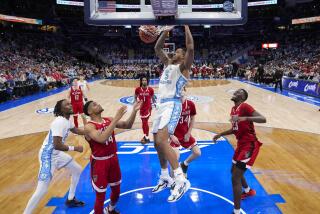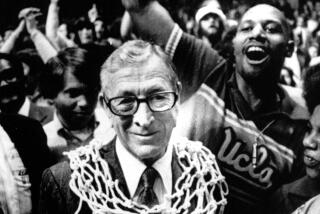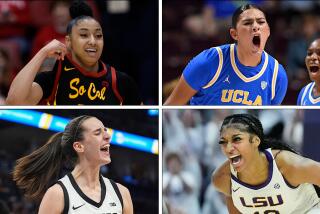College Basketball / Robyn Norwood : Tough to Make NCAA Tournament? It Sure Isn’t Easy to Pick the Field
It is less than three weeks until the announcement of the National Collegiate Athletic Assn. tournament field and the complexity of the task is already becoming evident.
There are the small considerations, such as that Brigham Young does not play or practice on Sundays for religious reasons, and therefore must be put in the Southeast or the East regional, the two that will play games on Thursday and Saturday.
For Brigham Young, the interesting decision would come if the team advanced to the NCAA final, scheduled for Monday, April 4. Would the Cougars, after a Saturday victory, choose not to practice the day before the title game? Brigham Young, of course, would have to survive the tournament field of 64 teams, along with one other team, just to consider the problem.
Thirty teams automatically qualify for the tournament, all but three by winning a conference tournament. The regular-season champion will be the automatic qualifier for the Big Ten, the Ivy League and the Assn. of Mid-Continent Universities, which do not hold tournaments.
The other 34 teams will be chosen March 13 by the NCAA basketball tournament selection committee. It will have to make room for highly regarded teams that were upset in conference tournaments. It will have to make value judgments on conferences, deciding whether a fifth-place team in the Atlantic Coast Conference is more deserving than a second-place team in the Atlantic 10. And it is guaranteed to make people--a lot of people--very, very upset.
“This is probably going to be the hardest selection process we’ve ever had,” said Arnie Ferrin, the chairman of the selection committee.
Part of the difficulty will arise from the fact that some conferences that are not traditionally powerful--such as the Western Athletic Conference--deserve numerous entrants this season. And part of it could arise if teams such as LaSalle of the Metro Atlantic Athletic and North Carolina A&T; of the Mid-Eastern Athletic, now undefeated in conference play, should lose in the conference tournaments. The committee, unable to justify two teams from such conferences, might leave them out altogether.
Both the Pacific 10 and the Pacific Coast Athletic Assn. will be interesting to watch. Barring a tournament victory, will Stanford’s likely second-place finish and upset of Arizona be enough? Will UC Santa Barbara’s two upsets of Nevada Las Vegas?
In 2 1/2 weeks, everyone will know.
In preparation for the NCAA tournament’s 50th anniversary celebration, to be held in conjunction with the Final Four in Kansas City, ballots for an NCAA All-Time Final Four team have been distributed at many games. Fans vote for players who have been in the Final Four since 1939, when Oregon won the first NCAA title, beating Ohio State, 46-33.
Among the players on the ballot, sponsored by USA Today: K.C. Jones (San Francisco, 1955), Wilt Chamberlain (Kansas, 1957), Oscar Robertson (Cincinnati, 1958-60), Jerry West (West Virginia, 1959), Bill Bradley (Princeton, 1965), Earvin Johnson (Michigan State, 1979), Larry Bird (Indiana State, 1979), James Worthy (North Carolina, 1981-82), Michael Jordan (North Carolina, 1982) and Steve Alford (Indiana, 1987).
UCLA players on the ballot: Walt Hazzard, Gail Goodrich, Kareem Abdul-Jabbar, Sidney Wicks, Bill Walton, Jamaal Wilkes, and Marques Johnson.
One more of note: Ferrin, the 1988 NCAA tournament selection committee chairman, who scored 22 points as a freshman for Utah, which won the national championship in 1944.
When Ferrin played, there were a few notable differences. No television, definitely no shot clock or three-point shot, and a much more selective selection committee. Only eight teams made the NCAA field until 1953, when it was expanded to 16.
Ferrin, formerly Utah’s athletic director, is assistant to the vice president at the school.
Before Arizona’s Steve Kerr became one of the best guards in the Pac-10, he was an aspiring journalist. As a senior at Palisades High School, he was co-sports editor of the school newspaper, along with Michael Silver, now Executive Sports Editor of the Daily Californian, the student paper at California.
On Feb. 4, three days before Kerr played his final game at Cal, Silver gave him an opportunity to talk back to the Cal fans in a guest column.
A sample of Kerr’s writing:
“I have great respect for you, not because you’re the wildest, zaniest and most die-hard fans in the Pac-10, nor because of the fact that you are the loudest and most obnoxious. No, the reason I respect you is because you’re the only people in the world who hate Reggie Miller more than myself.”
His parting shot:
“To all you sophisticated intellectuals who each year ask ‘Why didn’t you go to a real school, Steve?’ I say: I wanted to, but Stanford didn’t accept my application.”
Temple gave credence to its No.1 ranking with its 83-66 victory over North Carolina Sunday, the Tar Heels’ worst home loss in 13 years.
The Owls may not have made it past the second round of the NCAA tournament in recent years, but they are hardly Johnny-Come-Latelys to college basketball prominence.
At the beginning of the season, Temple ranked eighth in total victories among Division I teams with 1,262. Kentucky ranked first with 1,426, followed by North Carolina, St. John’s, Kansas, Oregon State, Pennsylvania and Notre Dame.
For what it’s worth, Temple is celebrating the 50th anniversary of its only national championship, which came in 1938. Temple went 23-2 that season and won the National Invitation Tournament, then considered the national championship.
Ed Boyle, a guard on the 1938 team, said the differences between the team he played on and this one were clear.
“We wouldn’t be allowed in the same gym with them,” Boyle told the Philadelphia Daily News. “We wouldn’t get 20 points off these kids. They don’t lack for a thing, as far as I can see.”
Add Temple: Increased school emphasis on basketball, financial and otherwise, has helped Temple return to basketball’s elite, former Temple and current Clipper assistant coach Don Casey believes. Much of that has come at the urging of Peter Liacouras, the university’s president.
Casey resigned in July, 1982, to become an assistant coach with the Chicago Bulls, after his relationship with Liacouras became strained when Casey, still the coach, learned that Liacouras had been holding talks with present Coach John Chaney.
More to Read
Go beyond the scoreboard
Get the latest on L.A.'s teams in the daily Sports Report newsletter.
You may occasionally receive promotional content from the Los Angeles Times.










